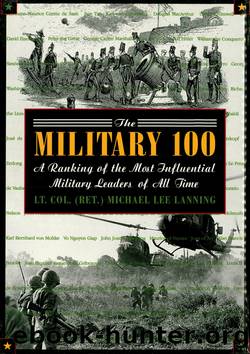The Military 100 by Michael Lee Lanning

Author:Michael Lee Lanning
Language: eng
Format: epub
Publisher: Kensington
Published: 2012-09-12T00:00:00+00:00
49
H. Norman Schwarzkopf
American General
(1934â)
As the commander of the U.S. Central Command, H. Norman Schwarzkopf led the coalition forces that defeated Iraq and liberated Kuwait in Operation Desert Shield/Storm (1990â91). Schwarzkopfâs leadership in producing a decidedly one-sided victory and his adept handling of the world media made him the best-known and most popular American general since World War II. He also represents those dedicated U.S. Army officers who fought the long and unpopular Vietnam War and remained in the service to restore the combat capability and integrity of their service.
Schwarzkopf was born on August 22, 1934, in Trenton, New Jersey, the son of a West Point graduate who made a career in the state police and the U.S. Army reserves. The senior Schwarzkopf was recalled to active duty during World War II. The younger Schwarzkopf first experienced the Mideast when he visited his father, then a military adviser to the shah of Iran, after the war.
Schwarzkopf attended Valley Forge Military Academy before his acceptance into the West Point class of 1956. Upon graduation and with a commission in the infantry, he served in troop assignments in the United States and Germany. After attending the University of Southern California for two years and earning a masterâs degree in guided-missile engineering, Schwarzkopf returned to West Point as a member of the faculty.
Following a year at the academy, Schwarzkopf requested reassignment to Vietnam, where he served as an adviser to a Vietnamese airborne division. During his tour he earned several valor decorations and the Purple Heart.
Schwarzkopf served on the West Point faculty for two years, attended the Army Command and General Staff College, gained an early promotion to lieutenant colonel, and returned to Vietnam. During 1969â70 he commanded the First Battalion, Sixth Infantry, 198th Infantry Brigade, of the Twenty-third (Americal) Infantry Division. Again he earned valor awards.
Disgruntled by the deterioration of the army in the protracted war and the growing antimilitary sentiments of the American public, Schwarzkopf considered leaving the army, but after much soul-searching he decided, like many of his contemporaries, to remain on active duty in order to rebuild the army. Over the next dozen years, he served in Alaska, Hawaii, Germany, and the United States in various staff and command assignments and advanced in rank.
In June 1983, Schwarzkopf assumed command of the Twenty-fourth Mechanized Infantry Division at Fort Stewart, Georgia. During the U.S. invasion of Grenada in October 1983, Schwarzkopf served as the deputy commander and the senior army leader of Operation Urgent Fury. In the successful but far from perfect operation, Schwarzkopf provided much of the coordination between the services and personally planned the rescue of U.S. medical students on the island.
With a third star on his shoulder, Schwarzkopf took command of the U.S. I Corps at Fort Lewis, Washington, in 1986 and left a year later to become the armyâs deputy chief of staff for operations in the Pentagon. In 1988, Schwarzkopf, now a full general, assumed the leadership of the U.S. Central Command at McDill Air Force Base, Florida, the military headquarters responsible for contingencies in the Middle East.
Download
This site does not store any files on its server. We only index and link to content provided by other sites. Please contact the content providers to delete copyright contents if any and email us, we'll remove relevant links or contents immediately.
Kathy Andrews Collection by Kathy Andrews(10520)
The remains of the day by Kazuo Ishiguro(7551)
Spare by Prince Harry The Duke of Sussex(4198)
Paper Towns by Green John(4169)
The Body: A Guide for Occupants by Bill Bryson(3801)
Be in a Treehouse by Pete Nelson(3212)
Harry Potter and the Goblet Of Fire by J.K. Rowling(3045)
Goodbye Paradise(2963)
Never by Ken Follett(2880)
Into Thin Air by Jon Krakauer(2701)
The Remains of the Day by Kazuo Ishiguro(2618)
The Genius of Japanese Carpentry by Azby Brown(2609)
The Cellar by Natasha Preston(2595)
Drawing Shortcuts: Developing Quick Drawing Skills Using Today's Technology by Leggitt Jim(2532)
120 Days of Sodom by Marquis de Sade(2438)
Architecture 101 by Nicole Bridge(2350)
The Man Who Died Twice by Richard Osman(2299)
Machine Learning at Scale with H2O by Gregory Keys | David Whiting(2291)
Fairy Tale by Stephen King(2070)
